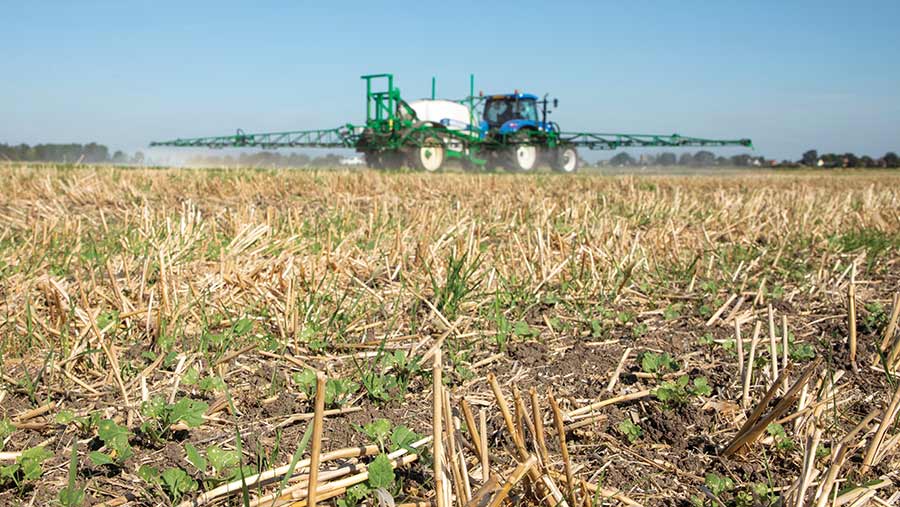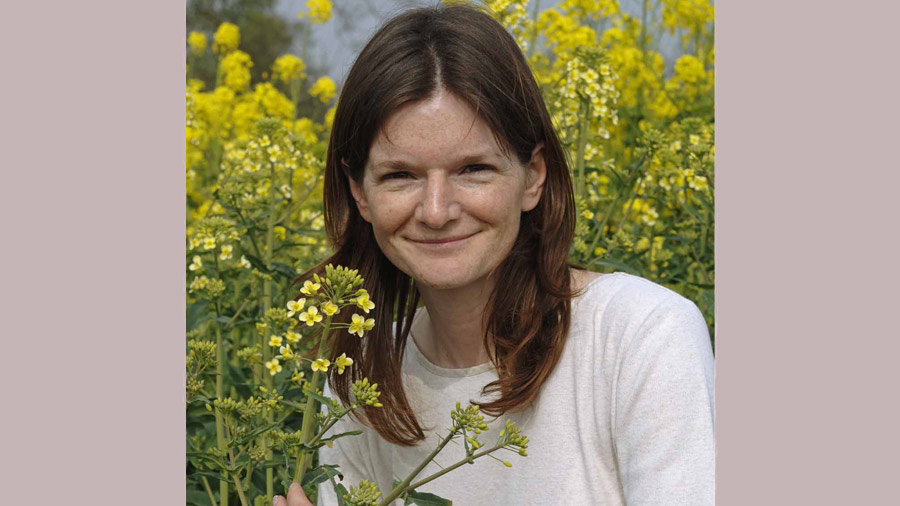How arable farmers can introduce SFI 2023’s no insecticide option
 © GNP
© GNP After another delay, applications for the Sustainable Farming Incentive (SFI) 2023 are due to finally open in mid-September, with the new no use of insecticide action being one of the most welcomed.
Changing the way a crop is grown to enhance its environmental benefits and address biodiversity decline is the basis behind some of the new SFI 2023 actions.
The no insecticide option, IPM4, is one of these actions – offering farmers £45/ha for land managed without the use of insecticides.
See also: Why wheat drill dates should be delayed this autumn
It can be used on its own, or together with the three other actions under the IPM offer, as part of the SFI’s more flexible, less-prescriptive approach.
IPM1 (produce an IPM plan), IPM2 (flower-rich margins) and IPM3 (companion crop) are all intended to help build natural predator numbers and provide protection, easing the pain of going chemical-free.
Added to cultural control techniques, such as delayed drilling, their implementation should help with the eventual goal of eliminating the use of sprays, by tipping the balance in favour of natural enemies.
On some farms, insecticides have already been confined to history.
On others, the transition is about to get under way, with growers keen to understand how to reduce the risk associated with not spraying for pests.
Farmers Weekly spoke to experts about how to approach this action.
Nick Wall, independent agronomist, Crop Management Partners and Groundswell Agronomy

Nick Wall © MAG/David Jones
The key consideration with an action like IPM4 is to do all the things you can to reduce the risk of pest attack before insecticides are removed, points out Nick Wall.
“You need to work with an IPM approach,” he says.
“If you have other measures in place, such as flower-rich margins, crop diversity and healthy soil, you are more likely to be successful, as beneficial and predator numbers should be higher.”
Risk level
Deciding what level of risk you are prepared to take is another important step, he adds, as simply not using an insecticide in a monoculture situation often works in the pest’s favour – pest populations can build quickly, so with a low natural predator population there will be a lag before they catch up to save potential crop loss.
“Aphids are attracted to unhealthy crops and those with high levels of nitrate, so it’s important to get plants photosynthesising to their maximum potential.
“Growers who use Brix measurements as part of their agronomy should be aiming for a reading above 9/10 – at this level crops are less susceptible to attack.”
There is usually groundwork to be done before inputs can be eliminated and patience is required, advises Nick.
“It might take a couple of years to get to where you want to be. Going cold turkey seldom works in the way you want it to.”
Barley yellow dwarf virus
With problems such as barley yellow dwarf virus (BYDV), there are cultural control techniques such as later drilling and genetic resistance bred into new wheat varieties that can reduce its incidence. Monitoring for aphids also helps.
There are also a number of useful decision support tools, such as the Rothamsted Insect Survey and the updated Adas/AHDB T-sum predictor model, he adds.
“Good agronomic practice is essential. There’s no doubt that milder autumns and winters increase the threat, as the virus-carrying aphids remain active for longer.”
He adds that while the SFI payment is not enough to cover the cost of BYDV damage – where 20-25% yield loss is typical – being aware of the risk is important.
Even farms that made two applications of insecticide last autumn didn’t necessarily escape crop damage.
Not all agronomic challenges related to pests have the same solutions, he warns.
Cabbage stem flea beetle
Oilseed rape drilling, for example, can’t be delayed for long, so the cabbage stem flea beetle threat is harder to avoid unless the whole farming system is working well and there are good numbers of natural predators.
He advises growers to map their farms to identify the high-risk fields, where there have previously been pest issues.
“They tend to be the more sheltered ones.” These may not be the right sites to enter land into the IPM4 action, he cautions.
In the same way, wheat following oats can be susceptible to frit fly attack, so may not be suitable.
Sam Cook, behavourial ecologist, Rothamsted Research

MAG/David Jones
Oilseed rape
There is no point in using an insecticide on oilseed rape, as all of the insect pests associated with the crop have high levels of resistance to pyrethroids, reports Dr Sam Cook.
For this reason, the oilseed rape crop could be a good place to start with the new SFI action, as chemical pest control is already difficult following the revocation of some products and the ineffectiveness of others.
IPM approaches have been shown to help with pest regulation, she advises.
Beneficials
“Growers need to have confidence in beneficials and must manage the agri-environment in such a way that allows these predators to do the job of an insecticide.”
For most, a combination of agronomic and habitat management techniques will support beneficial populations and increase the probability of pest kill, she adds.
In practice, that means reducing or eliminating tillage in most situations, increasing plant diversity throughout the rotation and around the farm, as well as cutting insecticide use on crops as far as possible.
“There’s no safe spray window for parasitoids, for example,” Sam points out.
“These are specialist predators and they need to be present in fields before the exponential increase in pest numbers. Spraying doesn’t help their cause.”
While there are still knowledge gaps in the identification and effectiveness of natural enemies, there has been work done on both generalist and specialist insects that are found in oilseed rape.
The one that has created the most excitement is a parasitoid known as Microtonus brassicae, which attacks the adult cabbage stem flea beetle, reports Sam.
“Up to 33% parasitisation rates have been detected in Rothamsted work,” she says.
“This particular parasitoid attacks flea beetles at the end of the summer, with the larvae then developing inside the beetle. None of the parasitised beetles lay eggs.”
Another parasitoid, Tersilochus microgaster, attacks flea beetle larvae, so helps to reduce populations for the following year, she adds.
Boosting the numbers of these beneficials can be done by reducing tillage – parasitoids pupate in the soil as cocoons, so ploughing buries them.
In the same way, carabid beetle numbers – some of which may help with flea beetle control by eating their eggs – are affected by tillage.
Plant diversity
Greater plant diversity both in and around fields will also help, with semi-natural habitats adjacent to fields helping to support natural enemies.
The use of trap crops, companion plants and extended rotations is encouraged, as are field margins.
“Remember that you need brassicas in these margins if you want to build up populations of brassica specialists. Forage rape is a good all-rounder.”
Companion plants are useful with early sown oilseed rape crops, but there is less need for them with later sowings, advises Sam.
“In the absence of insecticides, you need the basics of a good seed-bed and moisture at drilling.
“The problems that were seen with stem weevil last year resulted because neonicotinoid seed treatments have gone and there is already resistance to pyrethroids. So think of all the things you can do to support predators and beneficials.”
Case study: Costow Farms, Northamptonshire
Insecticides haven’t been used in either cereals or oilseed rape for the past seven years by grower Stephen Goodwin, vice-chairman of Base-UK.
He acknowledges that the farm has never had a bad barley yellow dwarf virus problem.
While that made his decision to stop spraying for aphids easier, his belief that insecticides were doing more harm than good was the main reason for eliminating them from his very diverse, mixed farming system.
Cultural controls
Stephen has also used cultural control techniques to manage any risk and pushed wheat drilling back to the end of September, pointing out that nothing is up before October.
“That’s helped with any pressure,” he says. “We haven’t seen any major issues, so fingers crossed that it remains that way. The changing climate does make it all much more of a lottery.”
He adds that beneficial numbers have increased in his regenerative system, also helped by his use of direct drilling, so he can see the biodiversity benefits of changing his approach.
Oilseed rape crops haven’t received an insecticide since testing confirmed there was 80% resistance to pyrethroids in the cabbage stem flea beetle population.
“They may be cheap and cheerful, but they wouldn’t work,” he stresses.
The Sustainable Farming Incentive 2023 payment of £45/ha is appealing to Stephen, who continues to look at what the scheme has to offer and whether it would work on his farm.
“In the meantime, we are going ahead with a new Mid-Tier Countryside Stewardship agreement.”

